light CHEVROLET VENTURE 1998 Manual Online
[x] Cancel search | Manufacturer: CHEVROLET, Model Year: 1998, Model line: VENTURE, Model: CHEVROLET VENTURE 1998Pages: 474, PDF Size: 25.26 MB
Page 333 of 474
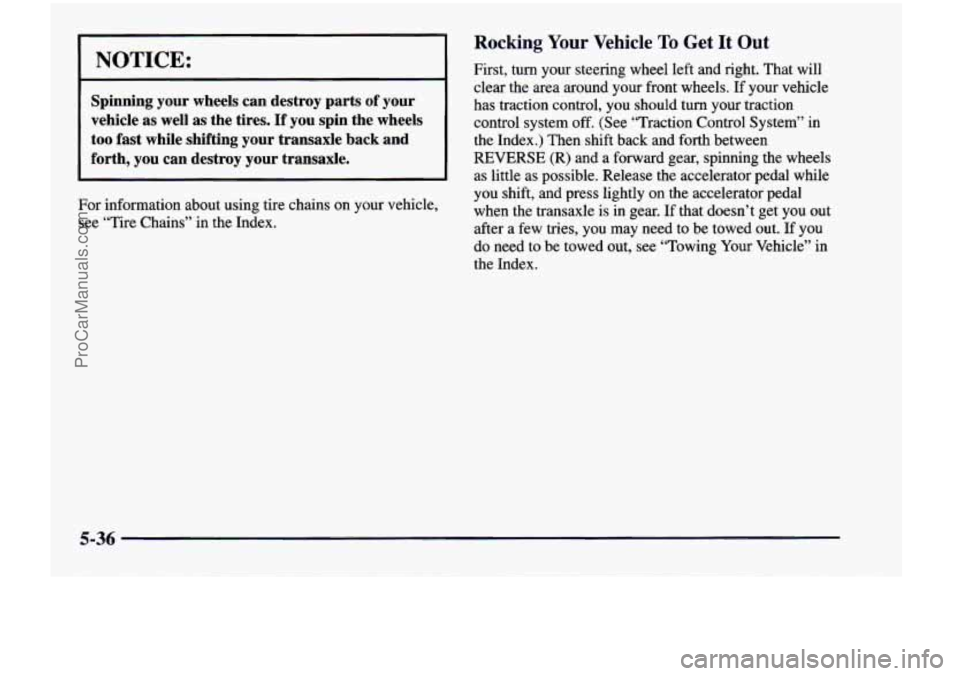
NOTICE:
~
Spinning your wheels can destroy parts of your
vehicle as well
as the tires. If you spin the wheels
too fast while shifting your transaxle back and
forth, you can destroy your transaxle.
For information about using tire chains on your vehicle,
see “Tire Chains”
in the Index.
Rocking Your Vehicle To Get It Out
First, turn your steering wheel left and right. That will
clear the area around your front wheels. If your vehicle
has traction control, you should turn your traction
control system off. (See “Traction Control System” in
the Index.) Then shift back and forth between
REVERSE (R) and a forward gear, spinning the wheels as little as possible. Release the accelerator pedal while
you shift, and press lightly on the accelerator pedal
when the transaxle is in gear. If that doesn’t get you out\
after a few tries, you may need to be towed out. If you
do need to be towed out, see “Towing Your Vehicle’’ in
the Index.
5-36
ProCarManuals.com
Page 342 of 474
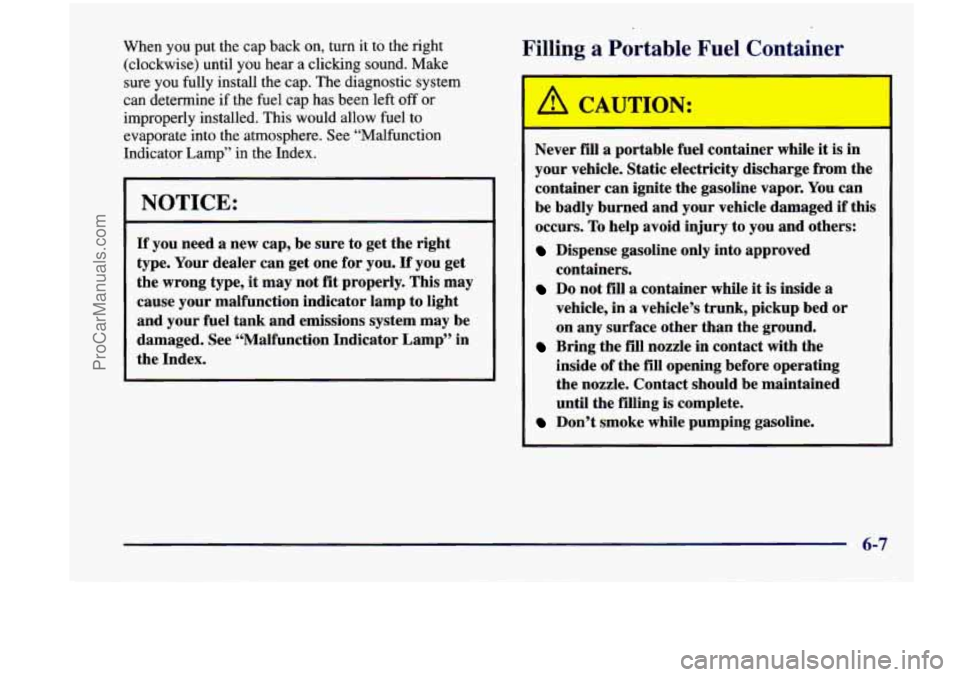
When you put the cap back on, turn it to the right
(clockwise) until you hear a clicking sound. Make
sure you fully install the cap. The diagnostic system
can determine if the fuel cap has been left
off or
improperly installed. This would allow fuel to
evaporate into the atmosphere. See “Malfunction
Indicator Lamp’’
* L the Index.
Fillinq a Portable Fuel Container
-.
NOTICE:
If you need a new cap, be sure to get the right
type. Your dealer can get one for you.
If you get
the wrong type, it
may not fit properly. This may
cause your malfunction indicator lamp to light
and your fuel tank and emissions system may be
damaged. See “Malfunction Indicator Lamp” in
the Index.
I
Never fill a portable fuel container while it is in
your vehicle. Static electricity discharge from the
container can ignite the gasoline vapor. You can
be badly burned and your vehicle damaged if this
occurs.
To help avoid injury to you and others:
Dispense gasoline only into approved
containers.
Do not fill a container while it is inside a
vehicle, in a vehicle’s trunk, pickup bed or
on any surface other than the ground.
inside of the fill opening before operating
the nozzle. Contact should be maintained
until the filling is complete.
Bring the fill nozzle in contact with the
Don’t smoke while pumping gasoline.
6-7
ProCarManuals.com
Page 346 of 474
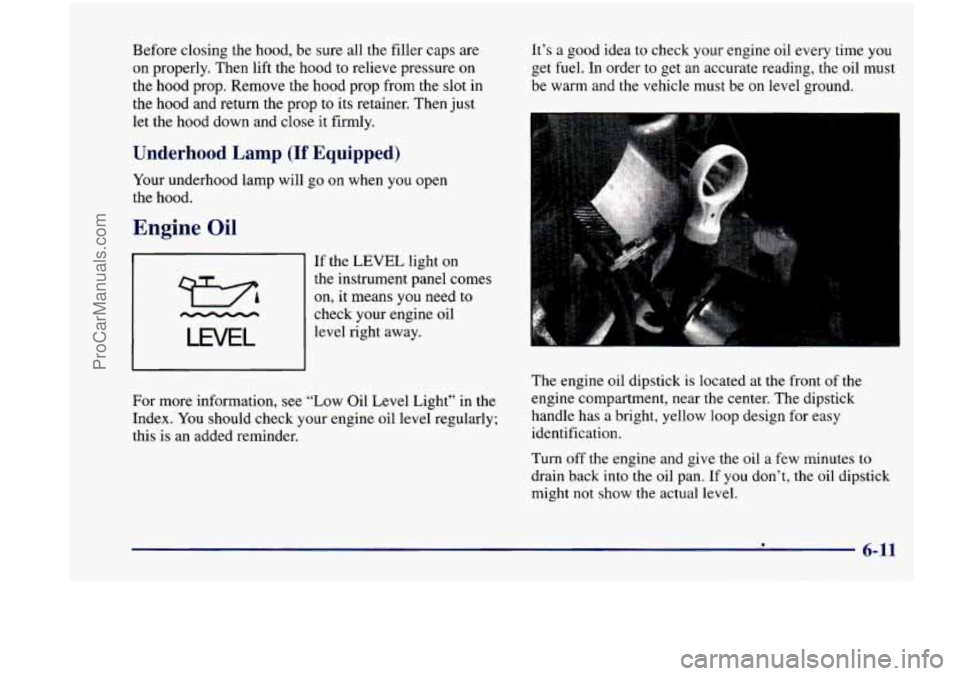
Before closing the hood, be sure all the filler caps are
on properly. Then lift the hood to relieve pressure on
the hood prop. Remove the hood prop from the slot in
the hood and return the prop
to its retainer. Then just
let the hood down and close it firmly.
Underhood Lamp (If Equipped)
Your underhood lamp will go on when you open
the hood.
Engine Oil
If the LEVEL light on
the instrument panel comes on, it means you need
to
level right away.
hhhhhh
LWEL
check your engine oil
For more information, see “LOW Oil Level Light” in the
Index. You should check your engine oil level regularly:
this
is an added reminder. It’s a good idea to check your engine oil every time
you
get
fuel. In order to get an accurate reading, the oil must
be warm and the vehicle must be on level ground.
The engine oil dipstick
is located at the front of the
engine compartment, near the center. The dipstick
handle has a bright, yellow loop design for easy
identification.
Turn off the engine and give the oil a few minutes
to
drain back into the oil pan. If you don’t, the oil dipstick
might not show
the actual level.
a 6-11
ProCarManuals.com
Page 356 of 474
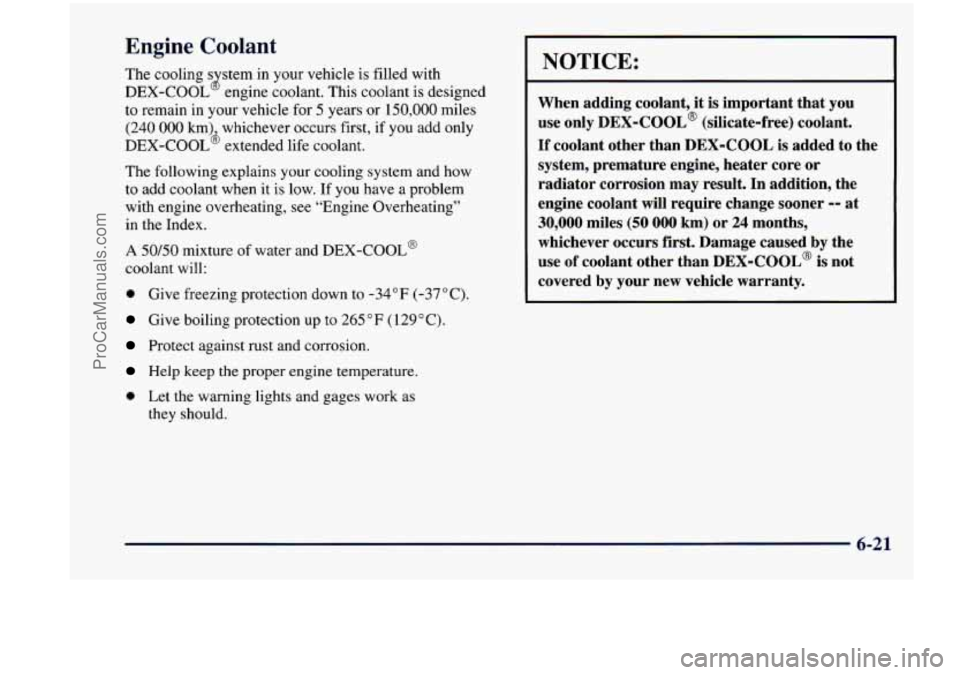
Engine Coolant
The cooling s stem in your vehicle is filled with
DEX-COOL engine coolant. This coolant is designed
to remain
in your vehicle for 5 years or 150,000 miles
(240 000 km) whichever occurs first, if you add only
DEX-COOLd extended life coolant.
J
The following explains your cooling system and how
to add coolant
when it is low. If you have a problem
with engine overheating, see “Engine Overheating”
in the Index.
A 50/50 mixture of water and DEX-COOL@
coolant will:
0 Give freezing protection down to -34°F (-37°C).
Give boiling protection up to 265 OF ( 129 O C).
Protect against rust and corrosion.
Help keep the proper engine temperature.
0 Let the warning lights and gages work as
they should.
~
~
NOTICE:
When adding coolant, it is important that you
use
only DEX-COOL@ (silicate-free) coolant.
If coolant other than DEX-COOL is added to the
system, premature engine, heater core or
radiator corrosion may result. In addition, the
engine coolant will require change sooner
-- at
30,000 miles (50 000 km) or 24 months,
whichever occurs
first. Damage caused by the
use
of coolant other than DEX-COOL@ is not
covered by your new vehicle warranty.
6-21
ProCarManuals.com
Page 358 of 474
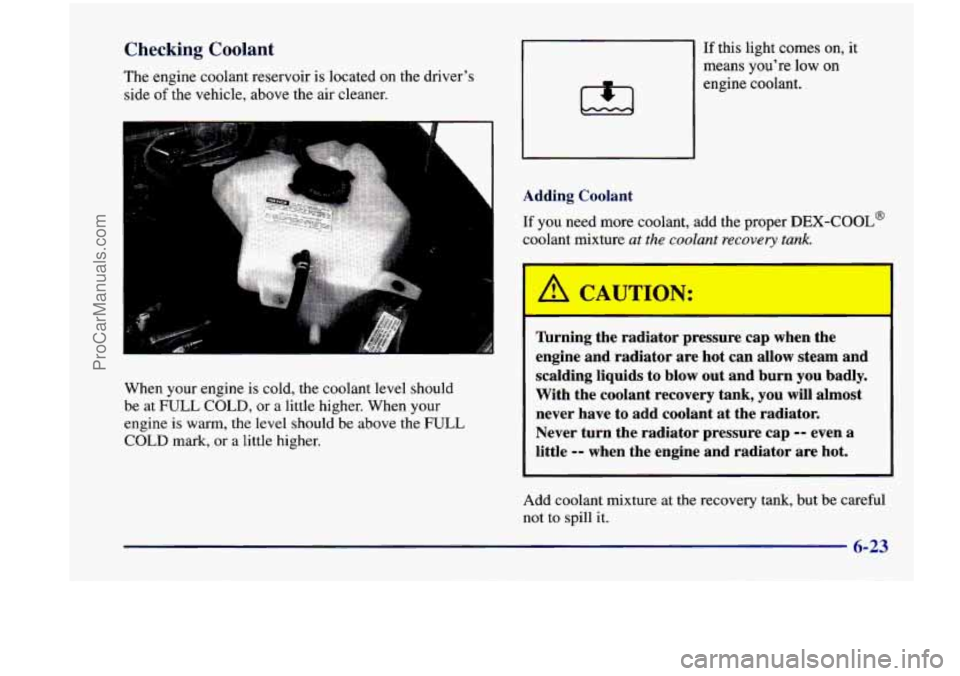
Checking Coolant If this light comes on, it
The engine coolant reservoir
is located on the driver’s
side
of the vehicle, above the air cleaner. means you’re low
on
engine coolant.
Adding Coolant
If you need more coolant, add the proper DEX-COOL@
coolant mixture
at the coolant recovery tank.
When your engine is cold, the coolant level should
be at FULL COLD, or a little higher. When your engine is warm, the level should
be above the FULL
COLD mark, or a little higher.
Add coolant mixture at the recovery tank, but be careful
not to spill it. ’hrning the radiator pressure cap
when the
engine and radiator
are hot can allow steam and
scalding liquids to blow out and burn you badly.
With the coolant recovery tank, you will almost
never have to add coolant
at the radiator.
Never turn the radiator pressure cap
-- even a
little -- when the engine and radiator are hot.
6-23
ProCarManuals.com
Page 362 of 474
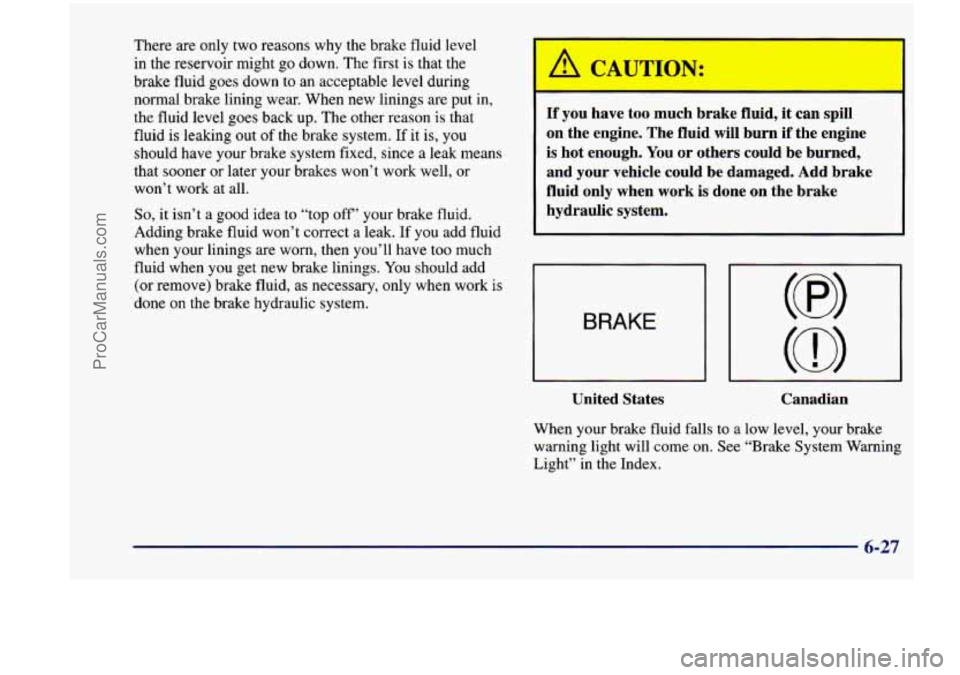
There are only two reasons why the brake fluid level
in the reservoir might
go down. The first is that the
brake fluid goes down to
an acceptable level during
normal brake lining wear. When new linings are put
in,
the fluid level goes back up. The other reason is that
fluid is leaking out of the brake system. If it is, you
should have your brake system fixed, since a leak means
that sooner or later your brakes won’t work well, or
won’t work at all.
So, it isn’t a good idea to “top off’ your brake fluid.
Adding brake fluid won’t correct a leak. If you add fluid
when your linings are worn, then you’ll have too much
fluid when you get new brake linings. You should add
(or remove) brake fluid, as necessary, only when work
is
done on the brake hydraulic system.
I A CAUTAN:
If you have too much brake fluid, it can spill
on the engine. The fluid will burn
if the engine
is hot enough.
You or others could be burned,
and your vehicle
could be damaged. Add brake
fluid only when work
is done on the brake
hydraulic system.
BRAKE
United States Canadian
When your brake fluid falls to a low level, your brake
warning light will come on. See “Brake System Warning
Light” in the Index.
6-27
ProCarManuals.com
Page 364 of 474
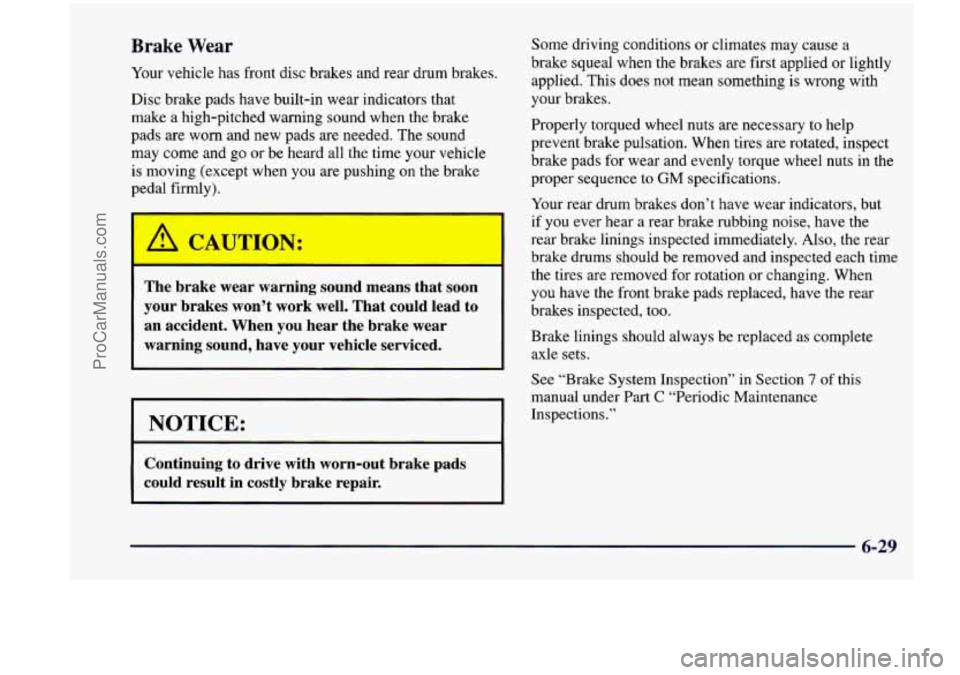
Brake Wear
Your vehicle has front disc brakes and rear drum brakes.
Disc brake pads have built-in wear indicators that
make a high-pitched warning sound when the brake
pads are
worn and new pads are needed. The sound
may come and
go or be heard all the time your vehicle
is moving (except when you are pushing on the brake
pedal firmly).
A CAUTION:
The brake wear warning sound means that soon
your brakes won’t work well. That could lead to
an accident. When you hear the brake wear
warning sound, have your vehicle serviced.
NOTICE:
Continuing to drive with worn-out brake pads
could result in costly brake repair.
Some driving conditions or climates may cause a
brake squeal when the brakes are first applied or lightly
applied. This does not mean something is wrong with
your brakes.
Properly torqued wheel nuts are necessary
to help
prevent brake pulsation. When tires are rotated, inspect
brake pads for wear and evenly torque wheel nuts
in the
proper sequence
to GM specifications.
Your rear drum brakes don’t have wear indicators, but
if you ever hear a rear brake rubbing noise, have the
rear brake linings inspected immediately. Also, the rear
brake drums should be removed and inspected each time
the tires are removed
for rotation or changing. When
you have the front brake pads replaced, have the rear
brakes inspected,
too.
Brake linings should always be replaced as complete
axle sets.
See “Brake System Inspection” in Section 7 of this
manual under
Part C “Periodic Maintenance
Inspections.”
6-29
ProCarManuals.com
Page 379 of 474
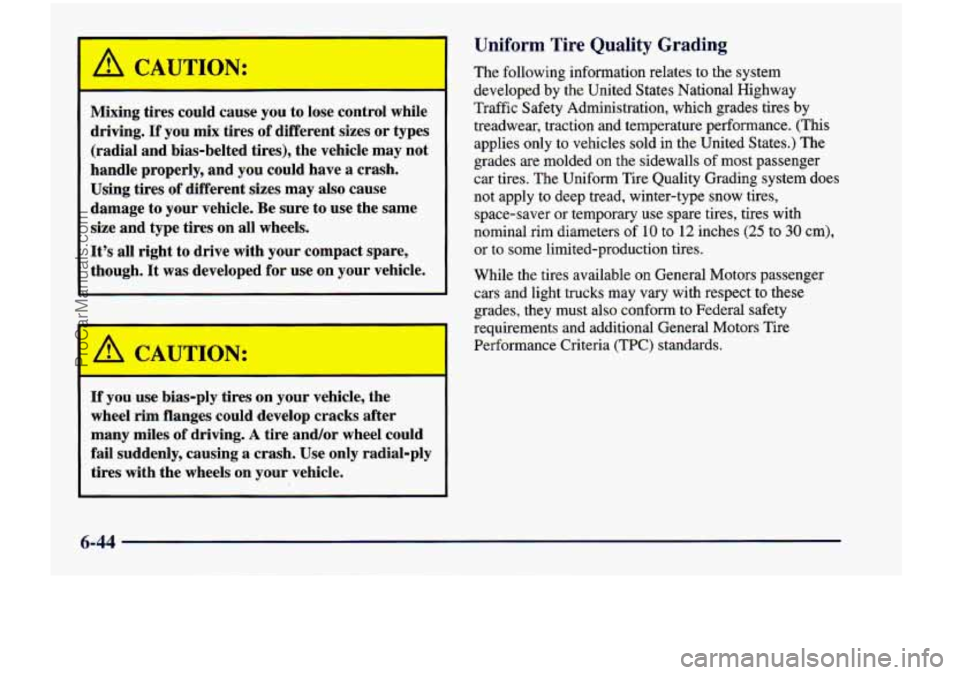
Mixing tires could cause you to lose control while
driving.
If you mix tires of different sizes or types
(radial and bias-belted tires), the vehicle may not
handle properly, and you could have a crash.
Using tires
of different sizes may also cause
damage to your vehicle. Be sure to use the same
size and type tires on all wheels.
It’s all right to drive with your compact spare,
though. It was developed
for use on your vehicle.
If you use bias-ply tires on your vehicle, the
wheel rim flanges could develop cracks after
many miles
of driving. A tire and/or wheel could
fail suddenly, causing
a crash. Use only radial-ply
tires with the wheels
on your vehicle.
Uniform Tire Quality Grading
The following information relates to the system
developed by the United States National Highway
Traffic Safety Administration, which grades tires
by
treadwear, traction and temperature performance. (This
applies only to vehicles sold in the United States.) The
grades are molded on
the sidewalls of most passenger
car tires. The Uniform Tire Quality Grading system does
not apply to deep tread, winter-type snow tires,
space-saver
or temporary use spare tires, tires with
nominal rim diameters
of 10 to 12 inches (25 to 30 cm),
or to some limited-production tires.
While the tires available
on General Motors passenger
cars and light trucks may vary with respect to these
grades, they must also conform to Federal safety
requirements and additional General Motors Tire
Performance Criteria (TPC) standards.
6-44
ProCarManuals.com
Page 390 of 474
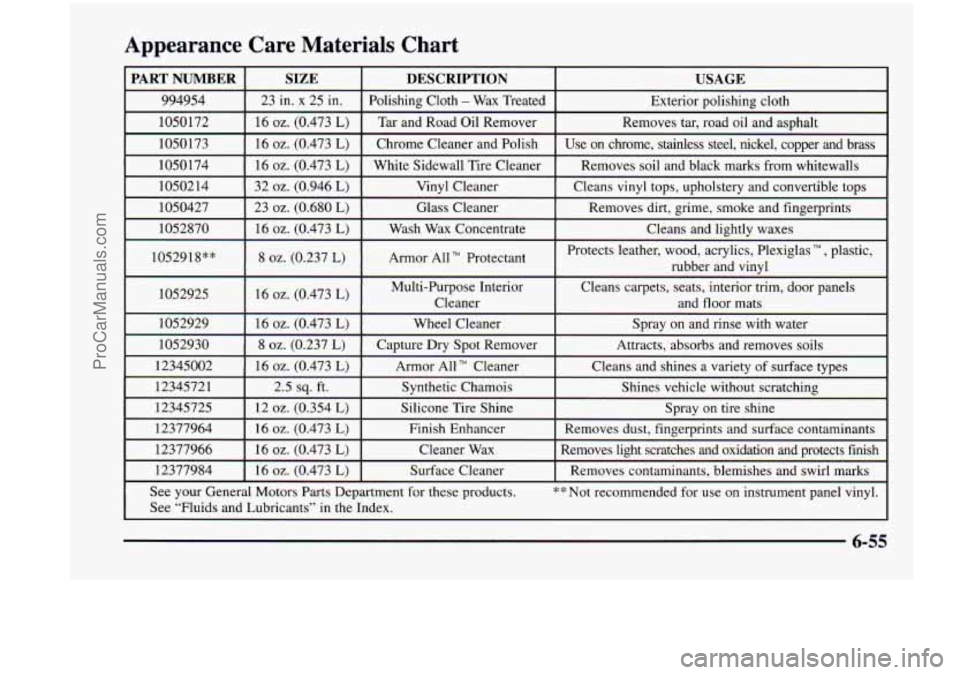
Appearance Care Materials Chart
PART NUMBER I SIZE
994954 I 23 in. x 25 in.
1050172 I 16 02. (0.473 L)
~~~~ ~~
1050173 16
oz. (0.473 L) 1052870 23
oz. (0.680 L) 1050427 32
oz. (0.946 L) 1050214
16
oz. (0.473 L) 1050174 16
02. (0.473 L)
DESCRIPTION
Exterior
polishing cloth
Polishing Cloth - Wax
Treated
USAGE
Tar and Road Oil Remover
Use on chrome, stainless steel, nickel, copper and brass
Chrome Cleaner and Polish Removes
tar, road oil and asphalt
Removes soil and black marks from whitewalls
White Sidewall Tire Cleaner
Vinyl Cleaner
Glass Cleaner Cleans vinyl tops,
upholstery and convertible tops
Removes dirt, grime, smoke and fingerprints
Wash Wax Concentrate Cleans and lightly waxes
1052918”” I 8 oz. (0.237 L) Armor All Protectant Protects
leather, wood, acrylics, Plexiglas TM , plastic,
rubber and vinyl
1052925 I 16 oz. (0.473 L) I
Multi-Purpose Interior
Cleans carpets, seats, interior trim, door panels
Cleaner and
floor mats I
1052929 I 16 oz. (0.473 L) I Wheel Cleaner I Spray on and rinse with water
1052930
Spray on tire shine
Silicone Tire Shine 12 02. (0.354 L) 12345725
Shines
vehicle without scratching
Synthetic Chamois 2.5 sq. ft. 12345721
Cleans and
shines a variety of surface types
Armor
All TM Cleaner 16 oz. (0.473 L) 12345002
Attracts, absorbs and removes soils Capture Dry Spot Remover 8 oz. (0.237 L)
12377964
See your General Motors Parts Department for these products. ** Not recommended for use on instrument panel vinyl.
Removes contaminants, blemishes
and swirl marks
Surface Cleaner
16 oz. (0.473 L) 12377984
Removes light scratches and oxidation and protects finish
Cleaner
Wax 16 02. (0.473 L) 12377966
Removes dust, fingerprints and surface contaminants
Finish
Enhancer 16 02. (0.473 L)
See “Fluids and Lubricants’’ in the Index.
6-55
ProCarManuals.com
Page 393 of 474
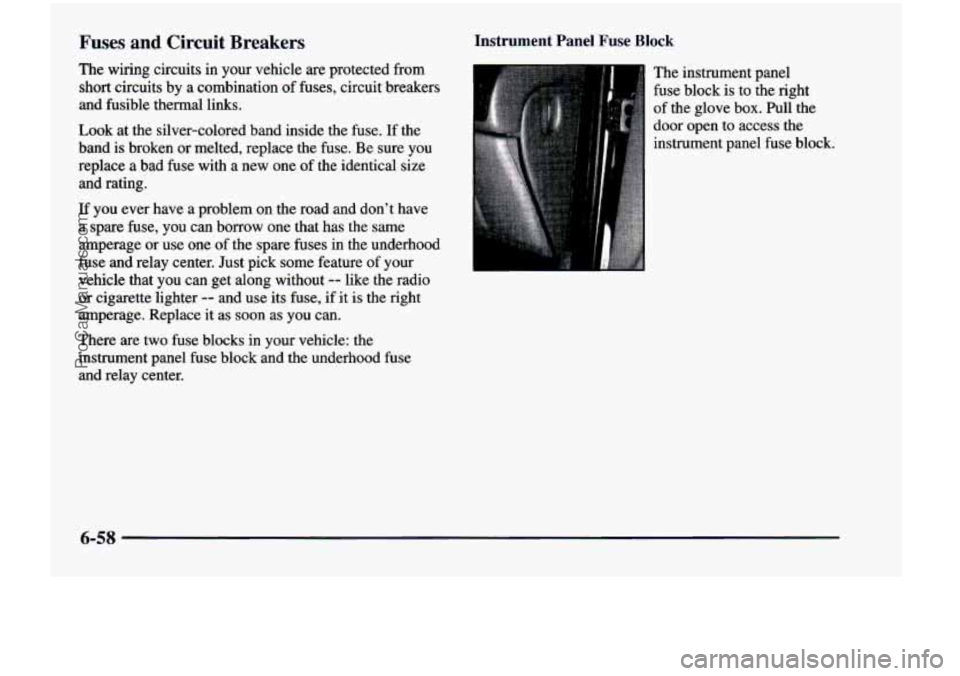
Fuses and Circuit Breakers
The wiring circuits in your vehicle are protected from
short circuits by a combination of fuses, circuit breakers
and fusible thermal links.
Look at the silver-colored band inside the fuse. If
the
band is broken or melted, replace the fuse. Be sure you
replace a bad fuse with a new one of the identical size
and rating.
If you ever have a problem on the road and don’t have
a spare fuse, you can borrow one that has the same
amperage or use one of the spare fuses in the underhood
fuse and relay center. Just pick some feature of your
vehicle that you can get along without
-- like the radio
or cigarette lighter -- and use its fuse, if it is the right
amperage. Replace it as
soon as you can.
There are two fuse blocks in your vehicle: the
instrument panel fuse block and the underhood fuse
and relay center.
Instrument Panel Fuse Block
The instrument panel
fuse block is to the right
of the glove box. Pull the
door open to access the
instrument panel fuse block.
6-58
ProCarManuals.com